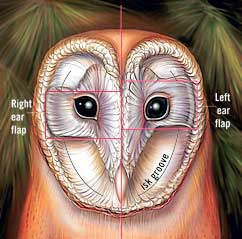Okay, for all you owl lovers out there, the "Why ____ Are Awesome" column will be devoted to owls for the next foreseeable future. Yes, that's right, I'm about to go on an owl binge. That means, for the next eleven weeks, you will learn about a different specie of owl each week. Yeah, that's right, ELEVEN WEEKS. That's because we have twelve species of owl regularly occurring in Colorado, everything from the mighty Great Horned Owl to the equally-mighty but much smaller Northern Pygmy Owl. Did you know that? There are twelve species and eleven weeks because I don't think I can write separately about the Eastern and Western Screech Owls.
So, I started writing about the first specie (can you guess which one I'll be talking about?), and I realized there are a lot of cool things about owls in general that you should know before we delve into the individual species. So this entry will be a sort of background post to get everyone on the same page, so that next week, when I start talking about facial discs and whatnot you'll all know what I'm talking about!
 |
| Short-Eared Owl (www.massaudubon.org) |
First of all, this is the list of owls that will be discussed:
-Burrowing Owl
-And, if you aren't all owled out by then, I'll cover the Great Gray Owl and the Snowy Owl, just because they're so special, even thought they don't normally occur in Colorado.
So, what do all of those birds have in common? They're all owls! And what does it mean to be an owl? It means you're the coolest of the cool, and that you're way better than all other birds, even raptors. Sorry, is that biased? Okay, let me try again.
Owls are a group of raptors (definition: birds who catch and kill their prey using their giant, deadly feet) that are largely nocturnal, and have wide faces in proportion to their beaks. But that's a generalization--not all owls are nocturnal, and some look wildly different than others. The smallest owl is the Elf Owl, coming in at just 1 ounce, and the heaviest is a tie between the Eurasian Eagle Owl and the Blakiston's Fish Owl: the large females in both species can weigh a whopping 10 pounds. For comparison's sake, a Great Horned Owl like me tops out at 5 pounds, and an average male Golden Eagle weighs 8 pounds.
 |
| Immature Elf Owl (www.nurkimaderes.blogspot.com) |
_J.Slaght_w.jpg) |
| Blakiston's Fish Owl (www.rareearthtones.org) |
Owls are highly specialized in a variety of ways. Most famously, they have excellent hearing. They have to be able to hear well because most of them hunt at night, when vision won't do them much good. There are a few reasons why their hearing is so excellent. One is that most owls have asymmetrically placed ears that allow them to triangulate the location of what they're listening to.
Also, they have a facial disc, a feather formation that funnels sounds to those asymmetrical ears like a satellite dish.
 |
| tucsoncitizen.com |
 |
| csus.edu Location of ears on a Barn Owl |
Also, they have a facial disc, a feather formation that funnels sounds to those asymmetrical ears like a satellite dish.
 |
| Great Grey Owl (www.valcitygal.wordpress.com) |
Even though owls have excellent hearing, is not quite enough to use exclusively, so their eyesight is pretty great, too. Owls are famous for having large eyes, as is seen in cartoons and art. And while the largeness of owls' eyes contributes to their awesome vision, it's actually the fact that their eyes are elongated that allows them to see so well. It would require a discourse in eye anatomy to fully explain it, but suffice it to say that longer eyes make for larger images on the retina, so the brain and neurons all have more material to work with, and so can see better than most other animals. But, there are a lot of different eye-shapes and eye-colors in owls, as you will see over the next few weeks.
 |
| Snowy Owl (www.2expertsdesign.com) |
In the same vein of adaptations-for-hunting-at-night, owls also have special feathers. Owls have an incredible ability to fly silently, and this is largely due to the structure of their feathers. While most birds have rigid feathers with straight edges, the leading edge of owl feathers is serrated, and that breaks up the air as it passes over the feathers, rendering them silent. Interestingly, the owls that don't have to be silent to sneak up on prey, namely the fishing owls, do not have feather serrations, and therefore are noisy fliers like most birds.
 |
| www.science.howstuffworks.com |
Okay, I think that's all you need to know about owls before I delve into the nitty-gritty of individual species. Now when I say, "The Great Grey Owl has the largest facial disc of all the owls", or, "Barn Owls have mastered the evolution of asymmetrical ears," or, "Burrowing Owls are largely diurnal, so they don't need such extreme facial discs," you'll know what I'm talking about.
 |
| This owl is excited. |
Okay, who's excited to hear all about why each of the owls the Humans treat at the Rocky Mountain Raptor Program are so cool? I know I am. I'll kick it off next week with....I'm not telling. It's going to be a surprise. Kind of.
In the meantime, don't forget that you can contact me via the comments below, or at my email address at talonsofdoom@gmail.com. Also, if you haven't liked the RMRP on Facebook or followed me on Twitter, I highly recommend that you do. And, finally, please vote for the RMRP in the Chase Giving charity drive today--help us win money from Chase Bank with a simple Facebook vote! Please contact the RMRP for any real questions for the Humans.

No comments:
Post a Comment